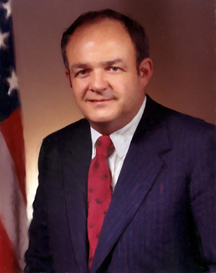Thomas C. Reed facts for kids
Quick facts for kids
Thomas Reed
|
|
|---|---|
 |
|
| 6th Director of the National Reconnaissance Office | |
| In office August 9, 1976 – April 7, 1977 |
|
| President | Gerald Ford Jimmy Carter |
| Preceded by | James W. Plummer |
| Succeeded by | Hans Mark |
| United States Secretary of the Air Force | |
| In office January 2, 1976 – April 6, 1977 |
|
| President | Gerald Ford Jimmy Carter |
| Preceded by | John L. McLucas |
| Succeeded by | John C. Stetson |
| Personal details | |
| Born | March 1, 1934 New York City, New York, U.S. |
| Political party | Republican |
| Education | Cornell University (BS) University of Southern California (MS) |
Thomas Care Reed (born March 1, 1934) is an American who held important roles in the United States government. He served as the United States Secretary of the Air Force from 1976 to 1977 under Presidents Gerald Ford and Jimmy Carter. Before that, he was a key helper to Ronald Reagan when Reagan was the Governor of California.
Contents
Early Life and Education
Thomas Reed was born in New York City, New York, in 1934. He went to Deerfield Academy for his early education. Later, he studied at Cornell University, where he earned a bachelor's degree in mechanical engineering in 1956. He was the top student in his class.
While at Cornell, he was part of the Air Force Reserve Officer Training Corps (ROTC) program. He was the highest-ranking student officer during his final year. After graduating, he became a second lieutenant in the United States Air Force. He was recognized as a distinguished military graduate.
Military Service and Science Work
Reed started his active duty with the Air Force in November 1956. For three years, he worked on the Minuteman Re-Entry Vehicle System. This system was part of the Air Force's missile division. During this time, he also studied at the University of Southern California and earned a master's degree in electrical engineering.
In 1959, he joined the Lawrence Radiation Laboratory at the University of California. Here, he worked on the physics of thermonuclear weapons. He left active duty in 1961 but continued to work as a consultant for the laboratory until 1967.
Business Ventures
In 1962, Thomas Reed started a company called Supercon Ltd. in Houston, Texas. He was the managing partner. This company developed and made special metal alloys that could conduct electricity without resistance (called superconducting) at very cold temperatures (known as cryogenic temperatures).
While still involved with Supercon Ltd., Reed also started the Quaker Hill Development Corporation in California in 1965. He held various leadership roles in this company, which worked on farming, recreation, and building projects in California and Colorado.
In 1973, Reed joined the United States Department of Defense. He worked as an assistant to the Secretary of Defense. In 1974, he was appointed as the director of Telecommunications and Command and Control Systems.
Political Career
Thomas Reed was also very active in politics. He helped organize Ronald Reagan's first campaign for governor of California in 1966. He also helped with Reagan's first attempt to become president in 1968. Reed built a national network of political helpers for Reagan.
In 1970, Reed successfully managed Reagan's campaign when he ran for governor again. In 1972, Reed worked on Richard Nixon's presidential re-election campaign.
Later, under President Reagan, Reed served as a vice chairman for the National Commission on Strategic Forces. He was a long-time friend of Reagan and his National Security Adviser, William P. Clark. Clark highly valued Reed's advice and asked him to help with defense and strategic planning reviews.
Author and Historian
Thomas Reed has also had a successful career as a writer.
In 2004, he published a book called At the Abyss: An Insider's History of the Cold War. This book shares his experiences during the Cold War, including his time at Lawrence Livermore National Laboratory and as an advisor to President Ronald Reagan. It talks about important events like the Cuban Missile Crisis and the role of the Central Intelligence Agency (CIA).
His second book, The Nuclear Express: A Political History of the Bomb and Its Proliferation, was published in 2009. He wrote this book with Danny B. Stillman. One interesting idea in the book is that China decided in 1982 to share its atomic knowledge with developing countries.
In 2012, Reed published a spy novel titled The Tehran Triangle. This fictional book is about Iran's efforts to build and use an atomic bomb in the United States.

